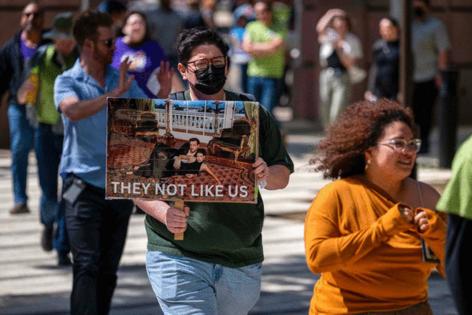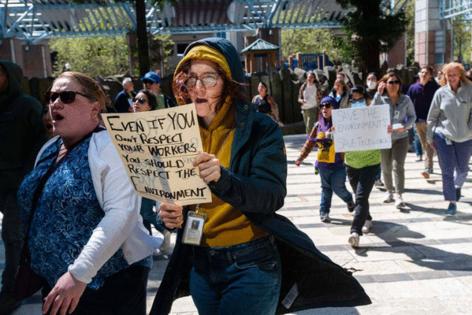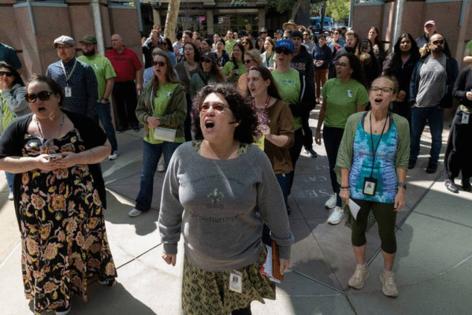Rallying California state workers have a message for Gavin Newsom on return-to-office
Published in News & Features
SACRAMENTO, Calif. — A protest led by scientists and other state employees Wednesday afternoon wasn’t as loud as one earlier this month. But the 100 or so workers who marched in downtown Sacramento carried the same angry message: Gov. Gavin Newsom’s return to office order needs to be defeated.
“Hell no RTO!” they chanted, as they walked around the California Environmental Protection Agency headquarters.
“Gov. Newsom needs to see how unpopular this is,” said Steven Gonzales, a training contracts analyst with the State Water Resources Control Board.
Wednesday’s protest was the latest effort in a public pressure campaign unions and their members are waging against the governor, who is requiring state workers to return to the office at least four days a week by July.
“It will send a message to Newsom about the unilateral decision he made,” said Debora Carlson, an accountant with the Department of Transportation.
Several labor groups have pending legal challenges against it with the California Public Employment Relations Board. But rulings on those are likely not going to occur before the order is set to go into effect, unless the board speeds up its review of the challenges.
So, unions are using public displays of displeasure through rallies, calls to lawmakers and other creative efforts to force the governor to reverse his decision — or at least negotiate.
“More solidarity brings more power,” said Carina Grove, who also works for the state water board.
A lack of evidence
Wednesday’s rally, hosted by the California Association of Professional Scientists, UAW Local 1115 and Local 1000 of SEIU, focused on the negative environmental impacts associated with the governor’s decision.
“You don’t have to be a scientist to know that putting more cars on the road will increase emissions,” said Michelle Romero, an environmental scientist with the Department of Toxic Substances Control.
Increasing the number of drivers on Sacramento-area roads isn’t going to help Newsom’s administration achieve its goal of reducing greenhouse gas emissions by 48% by 2030, she added.
A common sentiment among scientists Wednesday was the lack of evidence associated with the directive. Alice Henderson, another DTSC environmental scientist, said the executive order did not provide data that showed productivity or collaboration had declined as a result of hybrid work.
The executive order stated the four-day expectation “is an operational necessity, to maximize collaboration, cohesion, efficiency and accountability for delivering service to the public.”
But that explanation didn’t hold water with CalEPA employees on Wednesday who said they collaborated just fine working remotely. Driving into offices to log onto virtual meetings with colleagues — some of whom work in the same building — won’t make employees more productive, state workers said.
“There’s no reason to drive to these screens,” said Candace Keefauver, an Emergency Medical Services Authority employee.
Protesters said they planned to call state and federal lawmakers about the order. Many have already done so.
Assemblymember Maggie Krell, D-Sacramento, wrote a letter to Newsom on March 11, saying her office had received dozens of calls about the “stress, hardship and financial strain” it would cause.
Some people have called the office of Sen. Roger Niello, R-Fair Oaks, to express support of the directive, but most of those calls have come from state workers who are concerned about it.
A spokesperson for Niello’s office said the senator has not taken a stance on the issue but he believes the governor has the authority to issue the order.
“Drawing on decades of experience in running organizations and public service, his observation is that workforces function best when people actively collaborate in person,” the spokesperson said.
Representatives for other state lawmakers who represent the Sacramento area did not respond to emailed questions about the legislators’ stance on the order.
State workers are also considering other creative ways of pushing back. A Reddit commenter on Tuesday asked if people were interested in donating money to pay for a billboard that said: “You think traffic is bad now? Wait until July 1st! Thanks a lot, Newsom.”
Legal paths
As soon as labor groups learned Newsom was calling state workers back to offices, unions’ internal legal machinery kicked into high gear.
One day after Newsom issued the order, the Professional Engineers in California Government filed an unfair labor practice with the employment board, alleging the governor’s order violated state labor law.
“We’ve been at the forefront of this fight since March 3,” said Ted Toppin, PECG’s executive director.
Shortly after, two other unions representing state employees, SEIU Local 1000 and CAPS-UAW, filed challenges to the new telework policy with the state labor board.
The timeline, between filing a charge and the board issuing a decision, can take up to a year, said Tim Yeung, a public sector labor law expert.
After an unfair labor practice is filed, PERB decides whether to issue a complaint, which can take three to six months, though there is no deadline, Yeung said. If PERB issues a complaint, the case goes to a hearing, which can take another two months to take place. Finally, an administrative law judge aims to issue a decision in three to four months, he said.
All told, Yeung said, PERB won’t be able to conduct a hearing and issue a decision before the order goes into effect.
Aware of this time crunch, PECG filed a motion to expedite the process to get the union’s unfair labor practice in front of the labor board as soon as possible.
One week after the governor issued the order, the engineers’ union filed an emergency request to pause the order until PERB has the opportunity to investigate the charge and issue a decision. PECG argued that its bargaining leverage was hampered by the change to its members’ working conditions, and the labor board should block the order until the parties had time to negotiate telework.
Last week, the board denied the union’s request for injunctive relief.
Toppin said the union has additionally filed grievances on behalf of its members and managers and supervisors impacted by the telework policy change.
“We’re exploring all legal opportunities to resist the return to office,” Toppin said.
Interestingly, the state attorneys’ union has not yet filed a challenge to the governor’s directive with PERB, despite strong opposition from its members and president Tim O’Connor.
The California Attorneys Administrative Law Judges and Hearing Officers in State Employment has instead opted to meet and confer with California Department of Human Resources over the impact of the new telework policy to gather information.
“We’re lawyers, so we analyze the strategies and we like to create the record that we believe will be necessary for the next step,” O’Connor said.
If another resolution is reached short of a PERB action, “that would be great,” said O’Connor. He didn’t commit to what, if any, next steps the union would take.
Anica Walls, SEIU Local 1000 president, is well aware that the legal process is long. She said the largest union representing state employees is focused on taking the fight to individual departments. She noted that the governor’s order directs departments to consider “individual operational needs in determining whether to offer telework as an option.”
Walls said the union is fighting for “wins at the department and division level.”
Some state departments have declined to adopt the four-day policy, but those agencies aren’t directly under Newsom’s jurisdiction.
The Governor’s Office did not make anyone available to speak about the response it has received to the order. Instead, Tara Gallegos, a spokesperson for the Governor’s Office, responded with a statement.
“Our office welcomes the feedback we’ve received related to the executive order.”
_____
©2025 The Sacramento Bee. Visit sacbee.com. Distributed by Tribune Content Agency, LLC.












Comments